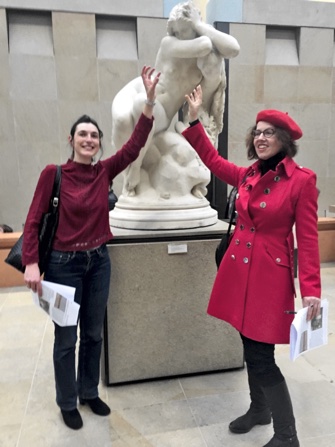Paris Update Art Notes
ART TREASURE TREKS

Two-thirds of the Red team in front of “Eve after the Fall” (1869), by Eugène Delaplanche.
A great way to get museum-averse kids (or adults) to take an art trek is to turn a visit into a treasure hunt. All the preparatory work for the Louvre and Musée d’Orsay has been done by Daisy de Plume, founder of THAT (stands for “Treasure Hunt at …”), who took a group of us on a sample tour of the Musée d’Orsay the other day. We were split into two teams, the Reds and the Pinks. After reading us the rules – no cheating by checking Wikipedia on cellphones or asking guides for directions; proof of success had to be provided by a photo of two team members in front of the work in question; etc. – de Plume let us loose on our own in the museum with a list of works (with photos and descriptions), which we had to find within a given time. Each one was worth a certain number of points, but more points could be scored by carefully reading the informative text about each work – 50 extra points for being photographed making a frog face in front of “Frog-Man” by Jean Carriès, for example. We Reds were a lackadaisical group, I’m afraid, and spent more time chatting than searching, so we lost out badly to the Pinks, but we did learn quite a lot along the way – that the aforementioned Carriès, for example, may have been high on morphine when he created his “bizarre hybrid man-amphibian sculptures.” The research that has gone into these art treasure tours, which encourage close looking, is impressive. I recommend it as a way to get a good overview of a museum without being overwhelmed by it and to learn something at the same time while keeping the little ones entertained. Heidi Ellison
Favorite